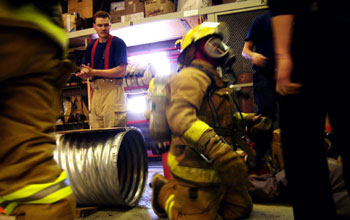Multimedia Gallery
Living and Working in Antarctica (Image 15)
Firefighters at McMurdo Station demonstrate firefighting techniques to the McMurdo community during a 2002 expo. McMurdo Station has a firehouse to protect the community against the high risk of fire, an extreme danger in Antarctica because of the arid environment and limited water supply. (Date of Image: Nov. 24, 2005) [One of 38 related images. See Next Image.]
More about this Series
This series of images, "Living and Working in Antarctica," was compiled to give the viewer a general idea of what it's like to live and work on the coldest, windiest and harshest continent on Earth.
When you think of human life in Antarctica, you may think of a small number of scientists, isolated from the rest of the world, living in subzero temperatures while performing research experiments, or stationed in remote field camps living with seals and penguins.
In actuality, life at the United States' research stations is much like life anywhere, with a diverse population performing day-to-day jobs, each important to the fabric that makes up the entire community.
The U.S. maintains three year-round stations in Antarctica, all of which are funded and managed by the National Science Foundation's U.S. Antarctic Program (USAP).
--Palmer, located on Anvers Island just west of the Antarctic Peninsula, population 10 to 46, the station has two major buildings and several smaller structures, a dock and a marine biology lab, and an atmospheric research facility.
--McMurdo, the operational hub and logistics center for U.S. operations, is located on a barren area of Ross Island in the southwest corner of the Ross Sea, population 235 to about 1,000. The station has more than 80 buildings, including the modern Albert P. Crary Science and Engineering Center for research in biology, Earth science, meteorology, upper atmosphere science and other disciplines.
--Amundsen-Scott South Pole, built on the Antarctic Ice Sheet in the continental interior at the geographic South Pole, it has a population of more than 200 in the summer. Research foci include astronomy, upper atmosphere science, meteorology and glaciology. The station, which is supplied entirely by McMurdo, 729 nautical miles to the north, just finished major modernization.
USAP employs many people in supporting roles to assist researchers and help maintain daily operations at the stations, on research vessels, and in remote field camps established for glaciologists, Earth scientists, biologists and others. These people provide the operational support required to build and maintain a small community.
Support personnel usually come during the austral summer, the period of extensive sunlight and comparative warmth that lasts roughly from October to February. The average summer temperature is around 36 degrees Fahrenheit, though temperatures in the Antarctic Peninsula may go as high as 60 degrees Fahrenheit.
These individuals are among the 3,500 Americans that will enter and leave Antarctica under the management of USAP over the course of the summer. USAP peak population at any given moment during the summer will be about 1,600 on land and 300 onboard the research vessels in surrounding waters. Most will leave at the end of the summer, but a small number will either stay or be replaced by others who will winter over to maintain the facilities and service scientific instruments so they will be ready for the following research season. The average winter population at McMurdo for example, is about 160. Wintering personnel usually stay for 8 to 10 months, from approximately January to October. The subzero temperatures (the coldest temperature ever recorded on Earth was here -- minus 70 degrees Fahrenheit), high winds and darkness of the long polar winter make travel nearly impossible. Except for a few flights, called "Winfly," in August, the winter staff are isolated until October.
The average work week at the U.S. facilities lasts six to seven days because schedules are often hard to keep due to unpredictable weather and difficulties associated with transportation and communication. Housing for most participants is dormitory-style rooms with roommates and shared bathroom facilities. Personnel supporting remote field camps spend significant time in the field.
Each research station is a small community with basic amenities like a general store that stocks personal articles and souvenirs, a firehouse and a church. And while the work is grueling, there is some after-hours recreation and entertainment, including safe hiking and cross-country skiing routes, crafts, a music room with a full selection of instruments, sports, exercise equipment, libraries, movies, a coffee house, a computer room with internet access, educational classes and science lectures. McMurdo Station even has the distinction of having one of a few remaining manually set bowling alleys in the world, circa 1961. Activities like Superbowl and holiday parties and Thanksgiving dinner help boost morale and make participants feel more at home.
Credit: Melanie Conner, NSF
Images and other media in the National Science Foundation Multimedia Gallery are available for use in print and electronic material by NSF employees, members of the media, university staff, teachers and the general public. All media in the gallery are intended for personal, educational and nonprofit/non-commercial use only.
Images credited to the National Science Foundation, a federal agency, are in the public domain. The images were created by employees of the United States Government as part of their official duties or prepared by contractors as "works for hire" for NSF. You may freely use NSF-credited images and, at your discretion, credit NSF with a "Courtesy: National Science Foundation" notation.
Additional information about general usage can be found in Conditions.
Also Available:
Download the high-resolution JPG version of the image. (344 KB)
Use your mouse to right-click (Mac users may need to Ctrl-click) the link above and choose the option that will save the file or target to your computer.



